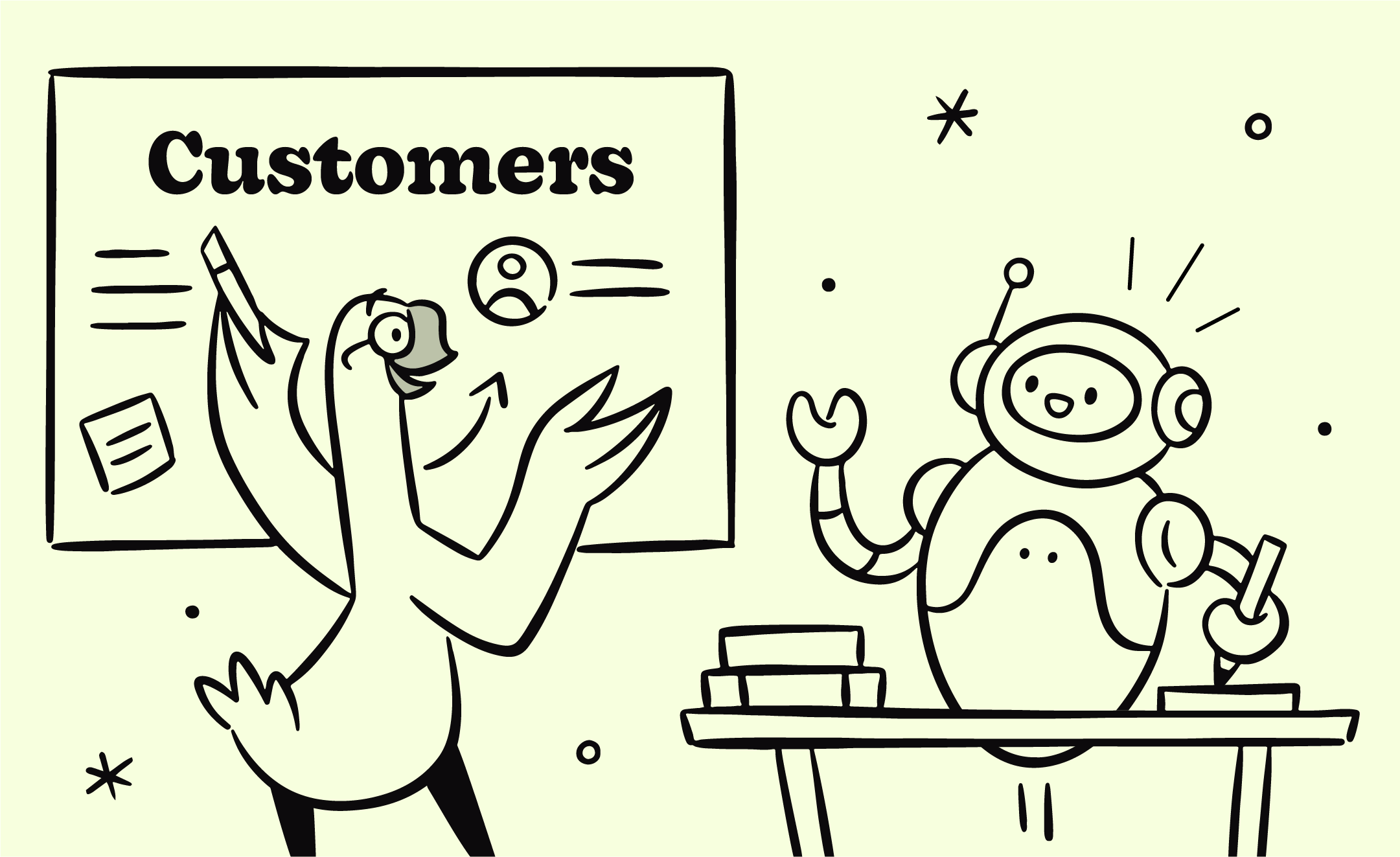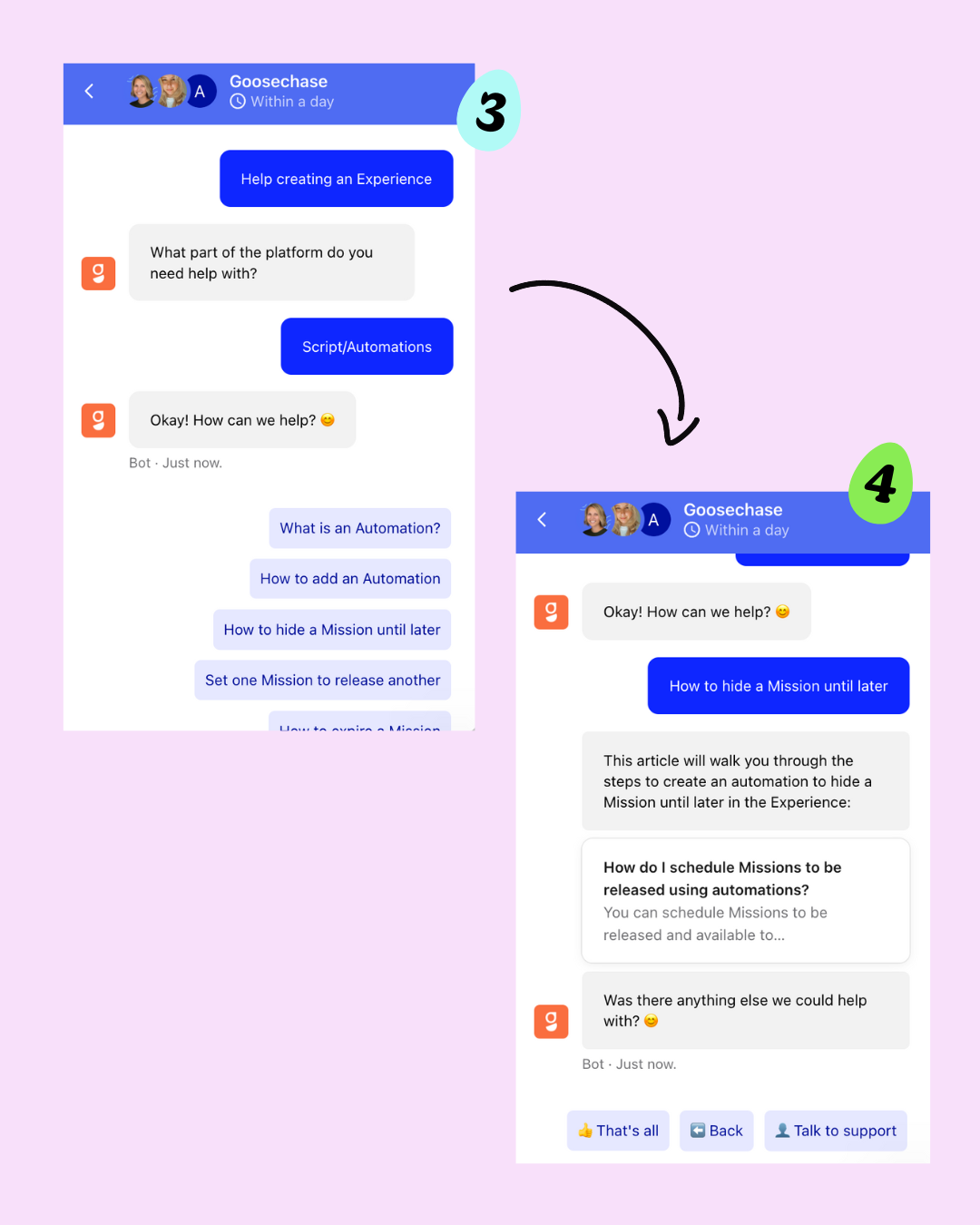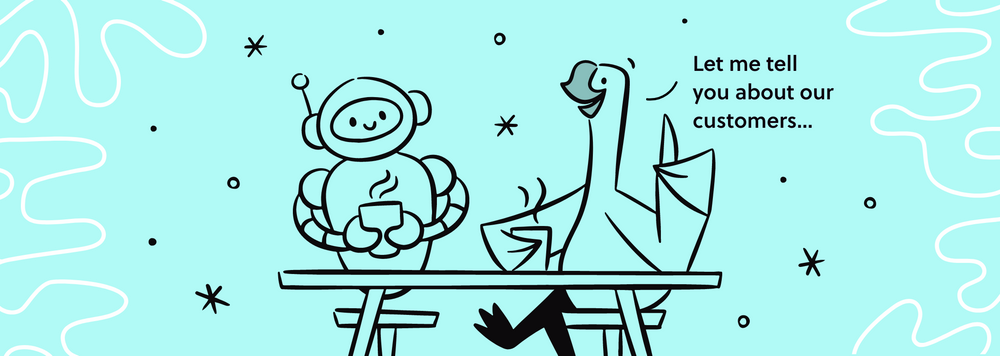Can I speak to a human?: Our Journey in Eliminating Chatbot Frustrations at Goosechase
Our mission is to make the world more fun, playful, and human. And that includes our Customer Support. Here's how we're doing it.
If you have ever reached out to Goosechase’s support, we’ve probably talked at one point or another! Hi, my name is Amber, I am the Customer Success Manager, although recently I have considered “Bot Wrangler” as my new job title. Let me explain...

"I need support"
The challenge at hand
As you can imagine, after 3 years of answering the same questions over and over, you start to question your very existence: What was the point of automated support if I was still answering the same question 30 times a week? Why do we chase the goose, when the goose usually chases us? 🌪️ And some of those thoughts are definitely more productive than others.
Following the first train of thought, I decided to do some deep diving into our customer conversations and reviewing chatbots’ success rates, and quickly realized that traditional chatbots were not effectively addressing our customers' needs. This was especially true when the customer was new to the platform or unfamiliar with the correct terminology.
A worry washed over me - has everything I’ve built (all the FAQ articles, automated bots, and macros) been for nothing? And at that moment (on the brink of insanity), it hit me:
“How could you ask a question about Goosechase, if you knew nothing about Goosechase at all?”

And to be honest, I had a great point. How would I know to use terms like "Mission", "Experience", "Script"? I wouldn't.
To improve the customer experience, I had to BECOME the customer. So with that in mind, I scooped up whatever sanity I had left, scrapped everything I had built for our chatbots in the past year, and started anew.
"Still thinking..."
How we're processing the challenge

Now what is the first thing we know about our customers? Well... at a very base level we can assume they are human (with a few geese sprinkled in). If we think about how humans learn, there is, for every person, a buffer time when learning “oh, this word is referring to this thing”. This buffer time can be shorter, or longer depending on the person, but regardless of the time, when someone new comes to your platform there are new features and new terminology that the customer needs to adapt to.
After working with a product for a period of time, it can be easy to forget this stage of the learning. Putting yourself in the customer's shoes, you soon realize that expecting new customers (who often have the most questions) to intuit platform terminology right away and then ask a well worded question with the correct phrasing is a bit unrealistic.
Now, as a general rule in the Customer Support industry, chatbots operate in a question and answer format, where the customer asks, and the chatbot provides the answer. Simple enough right?
In parallel to how humans learn, chatbots also have a buffer period. It takes time for them to learn new terminology, how questions are phrased, and which answers are appropriate for those topics. The caveat with this is that during this time, they may provide irrelevant answers, or no answers at all before fully understanding customer inquiries.
Now we have two learning buffer times working side by side to try and solve a customer's question.
And the result is what I have deemed “The endless chatbot loop”. At one point or another, we have all been caught in this cycle of trying to speak to a human on a chat, only to be redirected down a rabbit hole of choices and unrelated answers presented by the chatbots. It’s enough to make you want to throw your laptop at the wall...but then you remember how expensive it is, so you settle on slamming it shut very carefully and walking away swearing that you will never use the chat function on a website again.
Sound familiar?

"Did that answer your question?"
Putting a new chatbot in place
So how do we solve this? Do we wait for the bots to become better at interpreting questions? (shoutout to you, Chat GPT we are big fans at Goosechase 🤘)
Do we spam our users with annoying pop-up onboarding explaining all of the terminology?
Or - and this may be the insanity sneaking in again - do we just remove the questions all together…?
At Goosechase, we’ve always let the customers tell us what they want to see from the product. And really, the customers do that in support too - they ask us the same questions all the time!
If we listen to our customers, then we already know the questions they want to ask, but generally not HOW they will ask them. With that logic, if we present them with the questions first we can remove the need for them to phrase a question all together. 🤯
In order to do this, I needed to:
- Write a list of the most commonly asked questions
- Once I had that, I could then sort those questions into a user-friendly format where they could navigate to find those answers as easily as possible. For us, that meant categorizing by topics, and then by feature
- And then we present options of questions to choose from
- Once they select a question, the chatbot can serve them relevant support articles. And as always, we give them an option to speak to us directly


Honestly, these first two stages are not revolutionary. It is pretty standard in the industry to present topics for the customer to choose from. Where we make the change is either we present the question AND the answer, or WE (the humans in support) answer the question.
"Can I speak to a human?"
Making the world, and our chatbot, more human
Believe it or not, we actually want to talk to our customers! I relish every opportunity to send a specially selected GIF or spitball ideas for a fun new way to use our platform. For us, the chatbot isn’t a tool to stop customers from reaching us, or a way for them to find every answer they ever need. For us, it is a tool that needs to encompass the following:
- The ability for customers to speak to a human if they want to
- Routing conversations where a human touch would be a value add to the customer
- Gathering more context to better understand the customer's needs
- Answering frequently asked questions efficiently to protect our team’s bandwidth
- Collecting data on the features customers need assistance with to improve support articles and enhance platform clarity or design
As you may have noticed, the top 3 considerations are focused on our customers getting the help that they need and the value we can add to their experience with us. We have always been a customer-first company and our chatbots will be no exception.
Making sure customers could speak to a human was one of the most important considerations I had when building this model. If a user doesn't find their question in the list provided, they can simply select "other", type their question in, and be connected with a human. Most times, within three clicks of opening the chat. I’m not trying to build a labyrinth for them to navigate!

This puts the triaging of the conversation in the customers’ control instead of the bots, minimizing their frustration and the endless chatbot loop.
"So, how's it going?"
What we've seen so far
So far so good! While a large portion of our customers who go through the flows with the premade questions still end up talking to support, they are coming into our inbox with more context and knowledge. Which allows us to have productive conversations related to what they are looking to accomplish.
The new chatbot design has had a significant impact on our customer support metrics.
- Our median response time has decreased by 40 minutes since implementation
- 90% of our chat flows (out of 27 bots) are at/over a 70% completion rate. Meaning customers are getting the answers they need, OR they are talking to us
- Leads from our messenger have increased year over year, and the conversion of those leads are in line or surpassing our benchmark
- Most importantly, we no longer receive ‘I want to speak to a human’ messages
What’s next? Staying adaptable and human-centric
Is this the final form of our chatbot? Definitely not.
It’s not perfect, I am constantly iterating and monitoring our chat flows to make the customer experience as smooth as possible. Constantly assessing and reviewing our customers' behavior gives us great insights into what our customers need help with so we can continue to tailor our support.
Will we integrate more AI as it becomes available? Yes!
Our team actively uses AI in our day-to-day roles and I am really looking forward to integrating it more in our chat flows. AI can be an amazing tool, if used in the right ways. The goal is always to reduce friction and frustration for our customers while maintaining the human touch that makes our customer experience stand out. We just haven't fully worked out how AI will fit into our support processes just yet.
“Was there anything else I could help you with today?”
Customer support is not one-size fits all, but is often treated that way. Best practices are not applicable to every company, and this example is no different.
In all honesty, do I think that this format would fit large companies with 100’s of inbound questions a day? Probably not.
This method has not reduced our volume significantly (which is often the goal of automated support), but instead we’ve seen value in having increased context for conversations and how our chat has helped to educate. Which for us has resulted in faster response times, and more thought-out questions from our customers.
Think about how technologies are being used alongside your role and ask yourself “does this align with our goal?” or if you're using it this way just because everyone else is.
AI is a great example of this! It’s easy in the tech world to jump on the bandwagon for fear of not being left behind. The FOMO is real. We can see how quickly AI is being integrated into every platform, but for each company that use and integration will be slightly different.
As for Goosechase, we want to be sure if automated support is adopted, that it is adding value to the company and the customer - even if that means not letting the chatbots answer ALL the questions…for now.

What is Goosechase?
At Goosechase, experience is everything. Originally inspired by scavenger hunts, Goosechase is an online platform that enables organizations and schools to engage, activate, and educate their communities through delightful interactive experiences. Sign up and try creating a free recreational Experience, or check out our Pricing!





